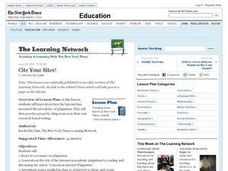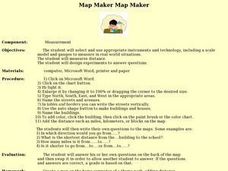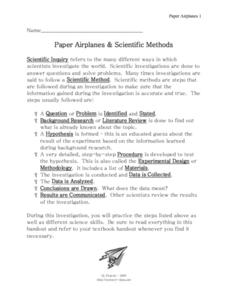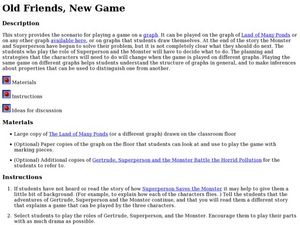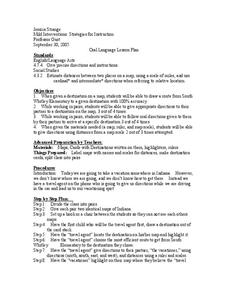Curated OER
Information Problem Solving
Students present information about an author of young adult literature using a HyperStudio stack.
Curated OER
3-D Texture Painting (Impasto)
A neat art project is on the horizon. Your class can experience impasto, or textured painting with this expressive art lesson. They design and then paint using the impasto technique. This is done by mixing toilet paper into the paint....
Curated OER
Gopher, Part 2: Gopherin'
Students explore how to access a gopher site using a root menu. Several options are presented with their definitions and the fastest routes examined in this lesson. The lesson is designed for librarians with little or no net experience.
Curated OER
Books for Teaching Dinosaurs
Young scholars investigate dinosaurs through books. In this lesson about dinosaurs, students read a variety of books about dinosaurs. Young scholars become familiar with dinosaurs through reading about them. Students learn that reading...
Curated OER
Research Skills: Evaluating Information and Sources
While this focuses on Ancient Rome, the objectives are improved research and information evaluation skills. In one class period, class members narrow their topic, research it, select the best information, log useful sources, and discuss...
Curated OER
Cite Your Sites
What information would you find in an almanac that you would not find in an atlas? What is the difference between a dictionary and a thesaurus? Using a Cite Your Sites worksheet on which they record their observations, groups participate...
Curated OER
The Magic of Cranberries
Students research climatic and soil conditions for growing cranberries and illustrate how cranberries grow. They research how cranberries are used past and present and create an a-b-c book on cranberries.
Curated OER
Reading With Fluency And Expression
Practice makes perfect, and this lesson provides a rubric to prove it! To improve their ability to read with fluency and expression, readers listen to a series of online stories in order to hear how a well-read story should sound. They...
Curated OER
Publishing Stories: Beginning, Middle, End
First and second graders explore the importance of having a beginning, middle, and end when writing stories. In this story writing lesson, students write short stories using the story diamond as a guide. They invite their parents to an...
Curated OER
Analyzing Word Use Through Guided Wordle
Even though this lesson is just a basic way to review verb usage, it takes a novel approach. First, pupils identify verbs that they use too often in their writing, and then they create a Wordle. Wordle is a website that provides graphic...
Curated OER
Map Maker, Map Maker
Map maker, map maker, make me a map! Your class can sing this tune as they work to create their own regional maps by taping paper to the wall, projecting an overhead transparency image, and tracing. Where this lesson plan intends for the...
Curated OER
Lesson Plan 18: Cleaning It Up
Careful proofreading is an important step in the writing process. After guided practice using a provided worksheet that details common grammar concepts, young writers refer to the worksheet as they proofread their own work. Although the...
Curated OER
Glossary, Index, and Table of Contents
Fourth graders use two separate sources to learn about index, glossary, and table of contents usage. In this library lesson plan, 4th graders use two books, Learning About Weather with Graphic Organizers, and The World Almanac for Kids,...
Curated OER
Doing Dewey
Young scholars discuss the Dewey Decimal Classification System and how it works. They organize ten books according to the Dewey Decimal Classification System.
Curated OER
Summarize This!
Students explore how to summarize a reading passage. They read non-fiction books. Students use a Venn Diagram to compare and contrast the two animals they read about. They write a summary using the information in their Venn Diagram.
Curated OER
Media Bias
Students analyze mass media to analyze media bias. In this media bias instructional activity, students read example situations and definitions about media bias. Students read and discuss how to be aware of media bias.
Curated OER
Photography
Young scholars practice the basic operation of a point and shoot camera while taking a variety of photographs. Included in this lesson are various activities that aid the student in becoming familiar with camera terminology and usage....
Curated OER
Soneka's Village
Students read a letter about the characteristics of the Maasai culture. After identifying them, they discuss how to live a pastoralist way of life. In groups, they discuss the roles of men and women in the country and what it might be...
Curated OER
Paper Airplanes & Scientific Methods
Seventh graders examine how to define scientific inquiry and the scientific method. In this paper airplane lesson plan students research airplanes, take notes then create an airplane trial.
Curated OER
Old friends, New game
Students create characters from a book. In this Language arts instructional activity, the students act out the story by role playing. The students learn how to articulate correctly, by working together to arrive at the same destination.
Curated OER
Oral Language
Students use distances on a map to draw a route, give directions, and follow directions. In this map lesson plan, students explain their route and directions orally.
Curated OER
Friendly Letter
Learners write friendly letters. In this friendly letters lesson, students write a friendly letter on the given template after being given direct instruction on how to write a friendly letter.
Curated OER
Become a Character: Adjectives, Character Traits, and Perspective
High schoolers use an online chart to match the character traits of a character in a book they are reading with specific actions the character takes. Students then work in pairs to "become" one of the major characters in a book and...
Curated OER
The Outsiders Debate Project
Eighth graders read the book The Outsiders for understanding. They develop arguments, with support, for six assigned debate points. They write a position paper based on six debate points. The dress up as a character in the book and...







